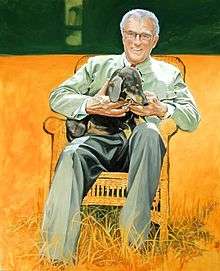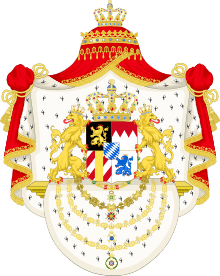Franz, Duke of Bavaria
| Franz | |
|---|---|
| Duke of Bavaria | |
 Portrait by Dieter Stein | |
| Head of the House of Wittelsbach | |
| Tenure | 8 July 1996 – present |
| Predecessor | Albrecht, Duke of Bavaria |
| Heir presumptive | Prince Max, Duke in Bavaria |
| Born |
14 July 1933 Munich, Germany |
| House | Wittelsbach |
| Father | Albrecht, Duke of Bavaria |
| Mother | Countess Maria Draskovich of Trakostjan |
| Bavarian royal family |
|---|
 |
|
HRH The Duke in Bavaria
|
|
Extended family members HRH The Dowager Duchess of Croÿ HRH The Dowager Duchess of Arenberg
The Rt Hon The Marchioness of Castro
|
Franz, Duke of Bavaria (German: Franz Bonaventura Adalbert Maria Herzog von Bayern; born 14 July 1933) is head of the House of Wittelsbach, the former ruling family of the Kingdom of Bavaria. His great-grandfather King Ludwig III was the last ruling monarch of Bavaria until deposed in 1918.
Franz was born in Munich. During the Second World War, the Wittelsbachs were anti-Nazi.[1] The family initially left Nazi Germany for Hungary but were eventually arrested when Germany invaded the country in 1944. Franz was only 11 at the time. He spent time in several Nazi concentration camps, including Oranienburg and Dachau.[1]
After the war, he was a student at the University of Munich and became a collector of modern art. Franz succeeded as head of the House of Wittelsbach, and as pretender to the Bavarian throne, on the death of his father in 1996. He lives at the Nymphenburg Palace in Munich. Franz is not married.
Also the current heir-general of King James II of England and VII of Scotland, Franz is, as Francis II, considered – by Jacobites – to be the legitimate heir of the Stuart kings of England, Scotland, Ireland and France.[2] A spokesman has said that "the Duke generally does not comment on issues concerning his familiar relationship to the Royal House of Stuart."[3]
Birth
Franz was born on 14 July 1933 in Munich, the son of Albrecht, Duke of Bavaria, and his morganatic wife, Countess Maria Draskovich of Trakostjan of the House of Drašković, a Croatian noble family. On 18 May 1949, when Franz was 15, his grandfather Crown Prince Rupprecht recognised the marriage of Franz's parents as dynastic, and Franz became a prince of Bavaria.
The Wittelsbach dynasty were opposed to the Nazi regime in Germany, and in 1939, Franz's father Albrecht took his family to Hungary. They lived in Budapest for four years before moving to their Castle at Sárvár in late 1943. In March 1944, Nazi Germany occupied Hungary, and on 6 October 1944 the entire family, including the 11-year-old Franz, were arrested. They were sent to a series of Nazi concentration camps, including Oranienburg and Dachau. At the end of April 1945, they were liberated by the United States Third Army.[4]
Education
After the war, Franz received his high-school education at the Benedictine Abbey of Ettal. He then studied business management at the University of Munich and in Zurich. Franz developed a passion for collecting modern art. Items from his private collection are on permanent loan to the Pinakothek der Moderne in Munich.[5] He is also an honorary trustee of the Museum of Modern Art in New York.[1]
Current activities
His 80th birthday party, in 2013, was held at the Schleissheim Palace near Munich. The party was attended by 2,500 guests,[6] including the former Minister-President of Bavaria, Horst Seehofer.[7]
In 2016, he became the donor of the project of restoration of the Statue of St. John of Nepomuk in Divina, Slovakia, realised under auspices of the Embassy of the Federal Republic of Germany in Slovakia. The project was honoured by patronage of His Majesty Norodom Sihamoni, the king of Cambodia and His Majesty Simeon II, the last tsar of Bulgaria.[8] The project was completed in the year 2017.[9]
Succession rights
Franz has never married. The heir presumptive to the headship of the House of Wittelsbach is his brother Prince Max, Duke in Bavaria. Because Max has five daughters but no sons, he is followed in the line of succession by his and Franz's first cousin Prince Luitpold[10] and, in the next generation, by the latter's son Prince Ludwig Heinrich of Bavaria (b. 1982).
Link to the Stuarts
The current senior heir-general of King James II of England and VII of Scotland, Franz is, as King Francis II, considered by Jacobites to be the legitimate successor to the Stuart kings of England, France, Scotland, and Ireland.[2] It is not, however, a claim which he pursues.[2][11][12][13][14][15]
The Jacobite succession, following English common law, transmits the right to the throne to or through women, and their descendants, whenever they have no brothers, unlike the semi-Salic law of the Wittelsbachs in Bavaria which only allows women to accede once all the men in the dynasty have expired. Therefore, the Jacobite succession will pass to Prince Max's eldest daughter, Sophie, Hereditary Princess of Liechtenstein.[4]
Franz is descended from the House of Stuart through the following persons:
- Henrietta, Princess of England (1644–1670), Duchess of Orléans, youngest daughter of King Charles I of England
- Princess Anne Marie d'Orléans (1669–1728), Queen consort of Sardinia
- Charles Emmanuel III of Sardinia (1701–1773), Duke of Savoy and King of Sardinia
- Victor Amadeus III (1726–1796), King of Sardinia
- Victor Emmanuel I of Sardinia (1759–1824)
- Princess Maria Beatrice of Savoy (1792–1840), Duchess of Modena
- Archduke Ferdinand Karl Viktor of Austria-Este (1821–1849), Prince of Modena
- Archduchess Maria Theresa of Austria-Este (1849–1919), Queen consort of Bavaria
- Rupprecht, Crown Prince of Bavaria (1869–1955)
- Albrecht, Duke of Bavaria (1905–1996)
- Rupprecht, Crown Prince of Bavaria (1869–1955)
- Archduchess Maria Theresa of Austria-Este (1849–1919), Queen consort of Bavaria
- Archduke Ferdinand Karl Viktor of Austria-Este (1821–1849), Prince of Modena
- Princess Maria Beatrice of Savoy (1792–1840), Duchess of Modena
- Victor Emmanuel I of Sardinia (1759–1824)
- Victor Amadeus III (1726–1796), King of Sardinia
- Charles Emmanuel III of Sardinia (1701–1773), Duke of Savoy and King of Sardinia
- Princess Anne Marie d'Orléans (1669–1728), Queen consort of Sardinia
Franz's successors to the Jacobite claim are:
- Maximilian, Duke in Bavaria (b. 1937)
- Sophie, Princess of Bavaria, Duchess in Bavaria (b. 1967), Hereditary Princess of Liechtenstein
- Prince Joseph Wenzel of Liechtenstein (b. 1995)
- Sophie, Princess of Bavaria, Duchess in Bavaria (b. 1967), Hereditary Princess of Liechtenstein
Titles, styles and honours
Titles and styles
Franz uses the titles Duke of Bavaria, of Franconia and in Swabia, Count Palatine of the Rhine,[16] plus the style "His Royal Highness".[6] [17] [18]
- 14 July 1933 – 8 July 1996: His Royal Highness Prince Franz of Bavaria
- (in Germany): Franz Prinz von Bayern
- 8 July 1996 – present: His Royal Highness The Duke of Bavaria
- (in Germany): Franz Herzog von Bayern
- (by Jacobites): His Majesty King Francis/François II of England, Scotland, France, and Ireland
- (by Othonists): His Majesty king Fragiskos I of Greece
Franz was styled Prinz von Bayern at birth.[19] In 1996, after the death of his father, he changed his style to Herzog von Bayern ('Duke of Bavaria').[20]
Honours


.svg.png)
.svg.png)

Academic
He is a Hereditary Senator of the University of Munich[28] and an Honorary Member of the Bavarian Academy of Sciences and Humanities.
Other
He holds many honorary positions in civic and religious organisations in Bavaria. He supports charitable enterprises helping orphans in Romania.[29]
Ancestry
Patrilineal descent
| Patrilineal descent |
|---|
|
See also
| Wikimedia Commons has media related to Franz, Duke of Bavaria. |
References
- 1 2 3 Cowell, Alan (11 July 1996). "Duke Albrecht Is Dead at 91; Pretender to Bavarian Throne". New York Times. Retrieved 30 November 2013.
- 1 2 3 Alleyne, Richard; de Quetteville, Harry (7 April 2008). "Act repeal could make Franz Herzog von Bayern new King of England and Scotland". Daily Telegraph. Archived from the original on 17 June 2008. Retrieved 22 June 2008.
- ↑ Walker, Tim, "Duke Francis of Bavaria given hope of claiming British throne", The Telegraph, 11 September 2011.
- 1 2 Hamilton, Tom (8 April 2008). "German Duke could claim Scots throne". The Daily Record. Retrieved 23 November 2013.
- ↑ Carla Schulz-Hoffmann and Peter-Klaus Schuster, Deutsche Kunst seit 1960 aus der Sammlung Prinz Franz von Bayern (München: Prestel-Verlag, 1985).
- 1 2 "The blue-blooded Bavarian Duke". the local.de. 25 July 2013.
- ↑ "Party fit for a king". The Local.de. Retrieved 23 November 2013.
- ↑ Sobola, Marek (2017). Príbeh svätojánsky, Socha sv. Jána Nepomuckého v Divine / The Story of St. John, Statue of St. John of Nepomuk in Divina / ដំណើររឿងរបស់ St. John, រូបចម្លាក់ St. John Nepomuk នៅក្រុង Divina / Die Johannisgeschichte, Die Staute des hl. Johannes Nepomuk in Divina / Историята на св. Ян, Статуята на св. Ян Непомуцки в Дивина. Slovakia: Servare et Manere, o. z. & Kysucké múzeum v Čadci. ISBN 978-80-972614-3-6.
- ↑ www.tkkbs.sk. "Biskup Galis požehnal obnovenú sochu sv. Jána Nepomuckého v Divine". www.tkkbs.sk. Retrieved 2017-08-06.
- ↑ Genealogie des Hauses Wittelsbach. München: Verwaltung des Herzogs von Bayern, 2000.
- ↑ Andrew Neather (10 September 2014). "R.I.P. GB: what happens if Scotland votes Yes in next week's independence referendum?". Evening Standard. Retrieved 23 August 2016.
- ↑ Douglas, Jason (19 August 2014). "Scottish Independence: Scots Ponder Secession Question in Referendum". WSJ. Retrieved 23 August 2016.
- ↑ Huggler, Justin (17 September 2014). "Could the Duke of Bavaria be the next King of Scotland?". Daily Telegraph. Retrieved 23 August 2016.
- ↑ Mudie, Keir. "Independence referendum: Duke of Bavaria in line to be next King of Scotland?". Daily Record. Retrieved 23 August 2016.
- ↑ "Opinion". Blogs.telegraph.co.uk. Retrieved 23 August 2016.
- ↑ Genealogisches Handbuch des Adels, Band 50, Fürstliche Häuser, Band IX, Limburg an der Lahn 1971, S. 7
- ↑ "Hilpoltstein-Botschafter-des-Landkreises". Donaukurier. 20 November 2013. Retrieved 23 November 2013.
- ↑ "Musikalisches-Geschlecht". Die Welt. 3 November 2013. Retrieved 23 November 2013.
- ↑ Genealogisches Handbuch des Adels, Band 50, Fürstliche Häuser Band IX. Limburg an der Lahn: C. A. Starke, 1971, page 7.
- ↑ Genealogisches Handbuch des Adels, Band 141, Fürstliche Häuser Band XVIII. Limburg an der Lahn: C. A. Starke, 2007, page 2.
- 1 2 "Der Bundespräsident / Terminkalender / Ordensverleihung an Franz Herzog von Bayern". Bundespraesident.de (in German). Retrieved 2017-07-26.
- ↑
- ↑ "Photographic image" (JPG). Merkur.de. Retrieved 2017-07-26.
- ↑ "Photographic image" (JPG). Upload.wikimedia.org. Retrieved 2017-07-26.
- ↑
- ↑ "Verleihung des Verdienstordens von Rumänien an Herzog Franz von Bayern | BOTSCHAFT VON RUMÄNIEN in der Bundesrepublik Deutschland". Berlin.mae.ro. 2017-07-18. Retrieved 2017-07-26.
- ↑ "Photographic image" (JPG). Berlin.mae.ro. Retrieved 2017-07-26.
- ↑ "The Jacobite Heritage". Jacobite.ca. Retrieved 23 August 2016.
- ↑ "Orphans International History: The Duke of Bavaria, a Princess, and OI Romania (2/06)". Oiww-history.blogspot.co.uk. 2008-04-14. Retrieved 2017-07-26.
Bibliography
- Adalbert, Prinz von Bayern. Die Wittelsbacher: Geschichte unserer Familie. München: Prestel, 1979.
- McFerran, Noel S. (1 August 2005). "Francis II". The Jacobite Heritage. Retrieved 22 June 2008.
- McFerran, Noel S. (22 November 2006). "The Royal Family, the Nazis, and the Second World War". The Jacobite Heritage. Retrieved 22 June 2008.
Franz, Duke of Bavaria Born: 14 July 1933 | ||
| Titles in pretence | ||
|---|---|---|
| Preceded by Duke Albrecht |
— TITULAR — King of Bavaria 8 July 1996 – present Reason for succession failure: Kingdom abolished in 1918 |
Incumbent Heir: Duke Max |
| Jacobite succession 8 July 1996 – present | ||
.jpg)